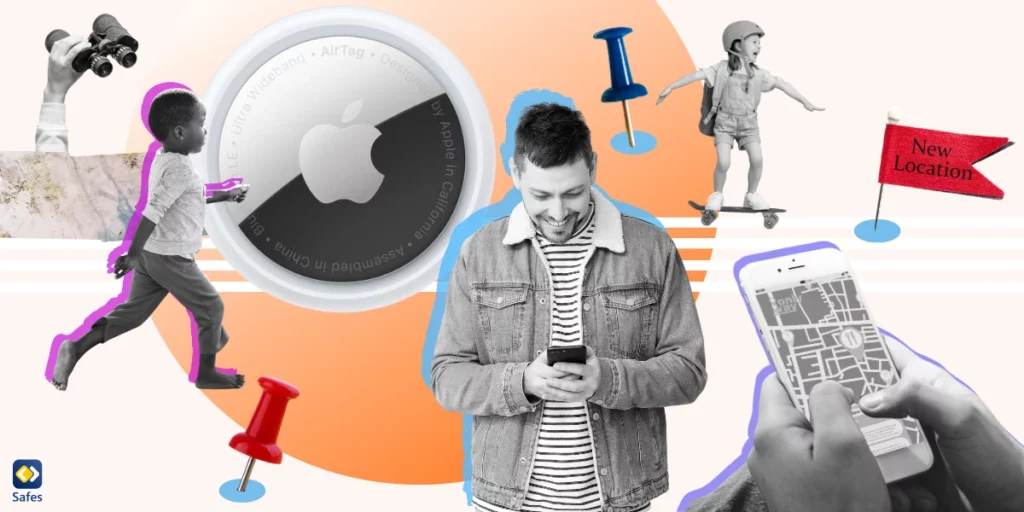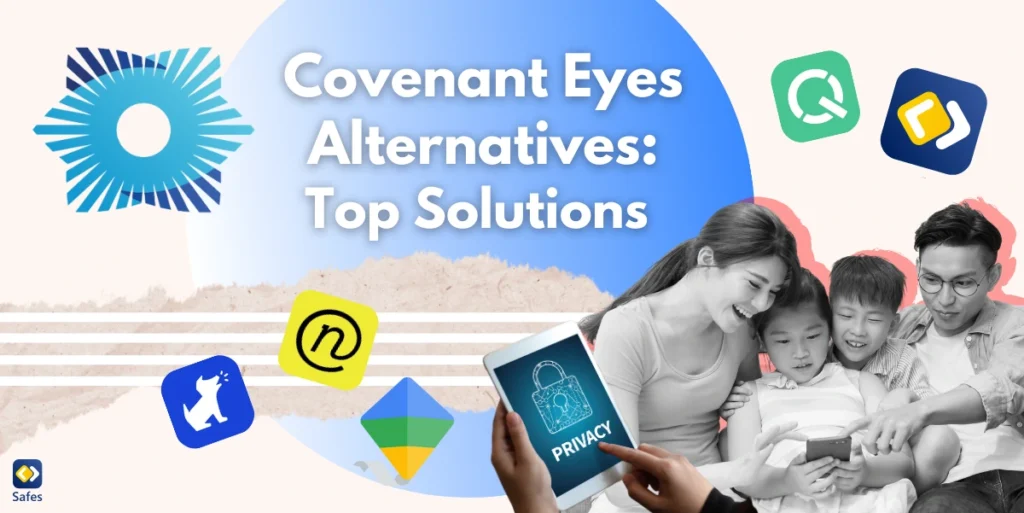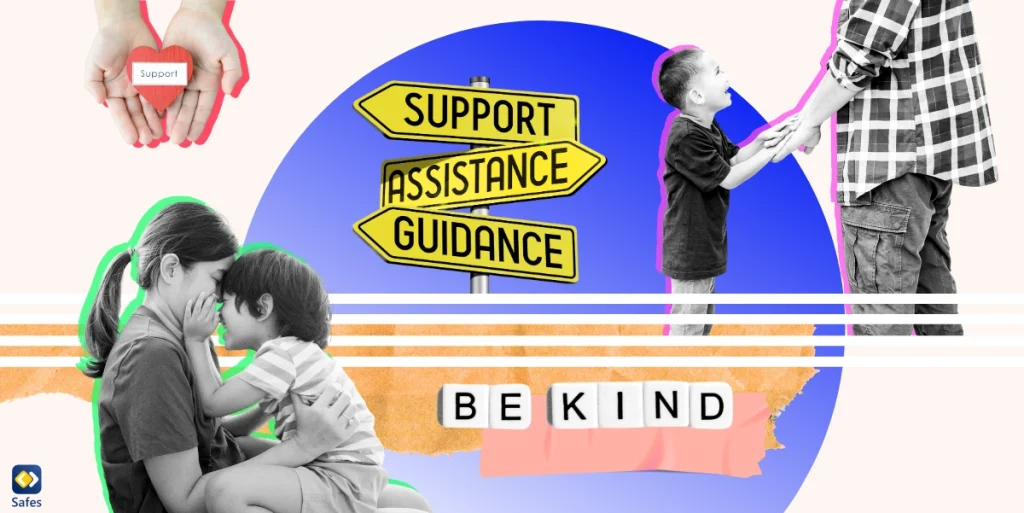You’ve probably heard about this shiny gadget from Apple called AirTags. These tiny, coin-sized devices help you find lost items like keys, wallets, and even your kid’s favorite stuffed animal. But, some parents are taking it a step further, using an AirTag for kids as a child tracking device! But should we hop onto this tech train without a second thought? No, let’s explore the ins and outs of AirTags and see if they’re a safe way to keep tabs on our little ones. We’ll discuss their pros and cons and suggest alternatives to you.
Download and Start Your Free Trial of the Safes Parental Control App
Introduction: How Apple AirTags Work?
Imagine a coin-sized gadget you can attach to almost anything: keys, wallet, or even your kid’s backpack. That’s an AirTag. The magic begins when you misplace the tagged item. Just pull up the Find My app on your iPhone, and it’ll guide you to your lost item like a mini-GPS.
AirTags come with this fantastic thing called Precision Finding. It uses augmented reality to guide you to your item. It’s like a game of hot and cold but way more high-tech!
But what if you’ve left your tagged keys at a café miles away? Nothing to worry about; the AirTag sends out a secure Bluetooth signal that can be detected by nearby devices in the Find My network. These devices send the location of your AirTag to iCloud. Then you can see it on a map. All this happens anonymously and is encrypted to protect your privacy.
In a nutshell, AirTags are nifty gadgets to help you keep tabs on your stuff. Plus, with a battery life of over a year and water resistance, these little trackers are both durable and handy.
![]()
Benefits of Using Apple AirTags for Child Tracking
Now that you know you can use Apple AirTags to track people, is your mind wandering down the path of, “Can I use AirTag to track my child?” Well, while AirTags aren’t precisely designed for that purpose, there are some exciting benefits to doing so.
First off, for all worried parents out there, AirTags could offer a bit of extra peace of mind. You’re not becoming a spy, just using tech to ensure your little ones are safe. It’s a modern take on the classic “I just want to know you got home safe” text.
Then there’s the AirTag location history feature. You could keep tabs on your child’s whereabouts, just in case they’re prone to misplacing themselves on the way home from school.
Best of all, you can use geofencing and receive notifications! Your phone buzzes when your child enters or leaves a certain area, like school or home. A virtual safety net, if you will.
And lastly, these little gadgets can be integrated with parental control apps for a more comprehensive monitoring solution. It’s tech, and parenting go hand in hand. Although, some parental control apps like Safes have built-in child-tracking features (more information later in this blog). But remember, open communication is vital here. Make sure your child understands why you’re considering this, and discuss it with them. It’s all about safety, never about spying!
Set Up AirTag for Child
Before anything else, have a conversation with your child about safety and explain how an AirTag works. Make it clear that this is a tool to help keep them safe, not to invade their privacy. Once you have their agreement:
- Open the Find My app on your iPhone
- Tap the Items tab, then tap “Add New Item”
- Select “AirTag” from the list and follow the on-screen instructions
- Name the AirTag something your child is comfortable with, like “Sarah’s Backpack”
Best Place to Put AirTag on Child
The most effective and comfortable places to put an AirTag are usually on items your child carries regularly, rather than on the child themselves. Some options include:
- Backpack: Attach it to an inside pocket or keyring loop
- Jacket: Sew a small pocket inside to hold the AirTag
- Shoe: Some companies make special AirTag holders that attach to shoelaces
Avoid placing the AirTag directly on your child’s body, as this can be uncomfortable and may make them feel overly monitored.
How to Responsibly Use AirTag with Your Child
Instead of focusing on how to “hide” the AirTag on your child, which could breach trust, consider these responsible practices:
- Regularly discuss the AirTag with your child, ensuring they’re still comfortable with its use
- Teach your child how to use the Find My app, so they can locate their belongings too
- Set clear guidelines about when you’ll check their location (e.g., only if they’re late coming home)
- As your child grows, periodically reassess whether the AirTag is still necessary
Remember, an AirTag should be just one part of a comprehensive approach to your child’s safety. It’s not a substitute for teaching your child about personal safety, building trust, and gradually allowing more independence as they grow older.
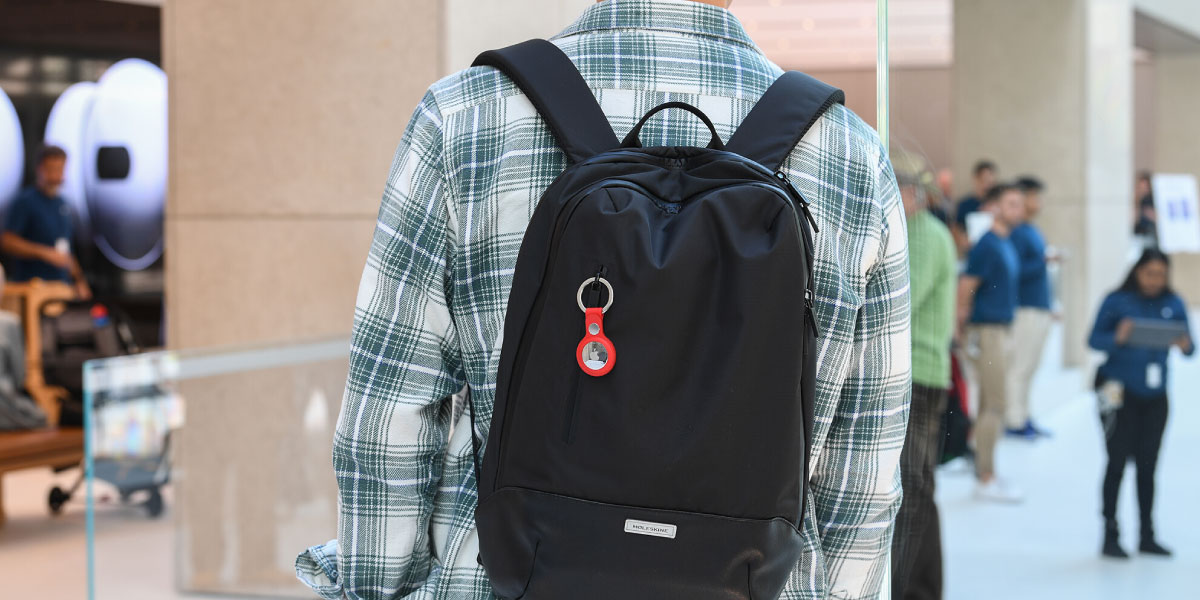
Potential Risks and Limitations of AirTags
The whole “hide AirTag on your child” idea sounds like a stellar one for keeping your kid safe. Still, there are some important considerations, potential risks, and limitations we need to chew over.
Privacy: Tracking devices like the AirTag can raise some thorny questions about our kids’ privacy and what the implications of that might be. Parents’ and Children’s Privacy Management about Sensitive Topics, published in the Journal of Family Issues, highlights the importance of open communication with children about sensitive issues such as their privacy and safety. So, you should have your child’s consent and communicate with them openly before using an AirTag. You wouldn’t just wake up one day and decide to put a tracker on your child without talking to them about it first, would you? Your child needs to understand why you’re considering an AirTag for their safety.
Lack of versatility: Apple AirTags are designed to pair with Apple iPhones or other Apple devices. So, if you’re not an Apple fan, then using an AirTag to track your child is out of the question. Although, you can use tracking devices made by other companies, such as Samsung Galaxy SmartTag or Xiaomi Ranres, that pair with Android devices.
Possibility of getting lost: A tracking device getting lost is ironic. But what we mean by that is Apple AirTags are tiny devices, so it’s only natural for kids to accidentally drop them.
Prone to mischief: Not trying to say every child might do such a thing, but some of them can cheat by leaving the AirTag _say at school_ while they’re somewhere else they shouldn’t be.
Embarrassment and bullying: You know how kids want to grow up faster than they should. For them, an AirTag dangling from their backpack can be a sign of being a small child pampered by their parents. This is especially the case with older children.
Best Practices for Using Apple AirTags on Children
Having talked about the benefits, risks, and limitations of AirTags, we want to see how to make Apple AirTags work for tracking your kid safely and securely. We’ve some tips and strategies for you to use these tech wonders on your little one.
Setting up AirTags Properly and Securely: Make sure you secure the AirTag to your child’s belongings, not on the child directly. And yes, keep your device updated for the best tracking experience.
Educating Children about the Purpose and Functionality of AirTags: Have a little tech talk with your child. Explain what AirTags are and how they work. Make them understand it’s not a toy but a tool for their safety.
Respecting Privacy Boundaries and Discussing Tracking Expectations: This might be tricky but utterly essential. Let your child know why you’re using the AirTag, not to snoop, but to ensure they’re safe.
Ensuring the Child’s Comfort and Well-being: Lastly, but most importantly, always put your child’s comfort first. If they’re uncomfortable with the tracking device, it’s time to reconsider. There are alternatives you can try, which we will discuss next.
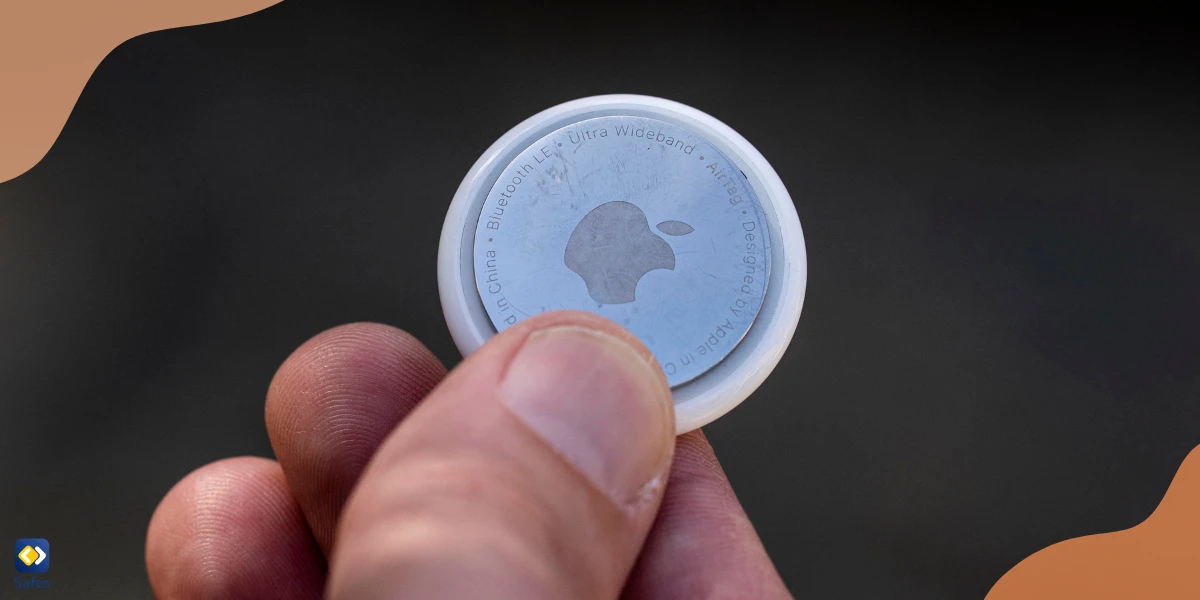
What’s Better than Apple AirTags for Kid Tracking?: AirTag Alternatives
As technology evolves, so do the options for keeping our children safe. Different new products have been designed with AirTag’s functionalities, such as watches, bracelets, and shoes. While AirTags aren’t designed for tracking people, there are several child-friendly alternatives that offer location tracking features. Let’s explore some options that prioritize both safety and your child’s growing need for independence:
AirTag Watch for Kids
Consider GPS-enabled smartwatches designed specifically for children. These watches often include:
- Real-time GPS tracking
- Two-way calling
- SOS buttons for emergencies
- Geofencing alerts
- Fun, kid-friendly designs
Safety Wearables Such as AirTag Bracelets for Kids
Look into safety wearables that are more visible and engaging for children. These might include:
- Colorful, comfortable bracelets with GPS tracking
- Pendants or necklaces with built-in safety features
- Clip-on devices that can attach to clothing or backpacks
Smart Clothing and Accessories Like AirTag Shoes for Kids
Consider smart clothing options that incorporate tracking technology more seamlessly:
- GPS-enabled shoe insoles
- Smart jackets with built-in tracking
- Backpacks with integrated GPS
While these are still emerging technologies, companies like Phonewatch and Trackimo are developing innovative solutions in this space.
Bluetooth Proximity Trackers
For shorter-range tracking (like in a park or mall), consider Bluetooth trackers designed for children:
- Tile Mate with a customized holder
- Chipolo ONE Spot in a kid-friendly case
Family Locator Apps
For older children with smartphones, family locator apps can be a great compromise. These apps allow for location sharing within the family, often with additional safety features.
Speaking of family locator apps, allow us to introduce you to Safes. It’s one of the best and most comprehensive parental control apps out there with family locator features! And the cherry on top? It plays well with all the major platforms—iOS, Android, Windows, and Mac. So, it doesn’t matter if you or your child uses a device with either one of those operating systems; you don’t need to install more than one app.
Start your journey to a safer digital world for your child with Safes! Sign up for our free trial today and gain access to advanced parental control features that extend beyond individual devices. Take the first step towards comprehensive online safety – begin your trial now!
With Safes, you’re not just tracking your child’s location but also monitoring and controlling their digital footprint. That’s a level-up, isn’t it? Plus, there’s no worry about anti-stalking features or fear of kidnappers detecting and disabling the tracker, like with AirTags.
AirTag for Kids Tracking: Final Words
We all agree Apple AirTag is a practical gadget that can help keep tabs on your kid and offers you peace of mind. But remember, there are some serious considerations, from privacy to potential misuse, that we can’t just brush under the carpet. And it’s crucial to educate your little one about the whole deal. AirTags have some limitations that might make you think of alternatives. If you’re still on the fence, there are always parental control apps to try. So, there you have it—AirTag for kids. It’s a choice, not a one-size-fits-all solution.
